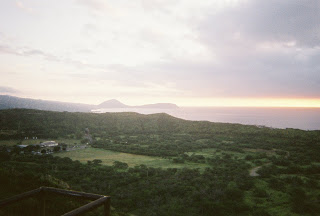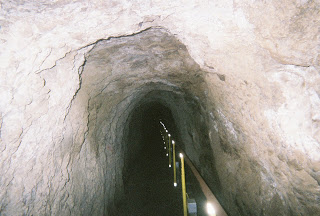World History
 (View from Diamond Head Crater, January 7, 2008.)
(View from Diamond Head Crater, January 7, 2008.)
 (Walking into the side of the crater.)
(Walking into the side of the crater.)
- Kamehameha Statue
(King Kamehameha Statue in Honolulu, January 2008) On my recent visit to Hawaii, I had the honor of seeing the famous Kamehameha Statue in Honolulu. It is right across the street from 'Iolani Palace which is the only royal palace in the United States....
- 'iolani Palace: Hawaiian Capitol Building
('Iolani Palace, 6 January 2008.)I was very fortunate to have the time to visit 'Iolani Palace during my recent visit to Honolulu, Hawaii. The tour guide who had taken me to Pearl Harbor drove through different parts of Honolulu and he dropped...
- Sanford B. Dole's 160th Birthday April 23, 2004
Dole's 160th Birthday April 23, 2004. This is an essay which examines the Hawaiian media coverage of Sanford B. Dole's 160th birthday. Dole was the first and only President of the Republic of Hawaii and under his leadership the Hawaiian people...
- History Of Hawaii
History of Hawaii. This is a decent (although uneven) history of the American state of Hawaii. Of particular interest is the last paragraph which takes aim at the Hawaiian Independence (separatist) Movement. Hawaiian independence from the USA is no more...
- The Worst Mistake In History Of The Human Race
When you study the Neolithic revolution, this is an interesting article (yes it is a few years old) by Jared Diamond arguing that we were, in many ways, better off prior to agriculture than we are now. Diamond argues that sexism was less, classes...
World History
At the Top of Diamond Head Crater
 (View from Diamond Head Crater, January 7, 2008.)
(View from Diamond Head Crater, January 7, 2008.)I was fortunate to be able to hike to the top of Diamond Head Crater on my recent trip to Honolulu, Hawaii. I woke up at 5 am to get ready for the hike. This was rather easy as my body time was still on Eastern Standard Time which was five hours off from Hawaii! I had signed up for a group tour and the guide picked me (and several others) up at the hotel at 6am in the morning.
We arrived at the crater shortly before sunrise as the crater is just off of Waikiiki Beach where the hotel was located. Once there, we began a short but strenuous climb to the top that took less than an hour. The trail was slick and steep at points and I noticed the tour guide eye several of the overweight and obviously out-of-shape tour members nervously at a few points of the hike.
Diamond Head Crater has a long history. Wikipedia notes, "Diamond Head is the name of a volcanic tuff cone on the Hawaiian island of O'ahu and known to Hawaiians as L?'ahi. Its English name was given by British sailors in the 19th century, who mistook calcite crystals embedded in the rock for diamonds. It is located on the coast east of Waik?k?, Honolulu...Diamond Head, like the rest of the Honolulu Volcanics, is much younger than the main mass of the Ko'olau Mountain Range. While the Ko'olau Range is about 2.6 million years old, Diamond Head is estimated to be about 200,000 years old and extinct for 150,000 years. The eruption that built up Diamond Head was probably very brief, lasting no more than a few days. It was probably explosive, since when the cone was originally formed, the sea level is thought to have been higher and the vent burst erupted over a coral reef. Another factor probably contributing to the eruption's explosive nature was that rising magma would have come into contact with the water table. The eruption's relatively brief length is thought to explain why the cone today is so symmetrical."
 (Walking into the side of the crater.)
(Walking into the side of the crater.)After the Hawaiian Revolution of 1893, Hawaiians loyal to the Hawaiian Monarchy fought several battles in the Diamond Head Crater against Republic of Hawaii soldiers in an attempted counter-revolution. Despite covert assistance from the United States and President Grover Cleveland, the attempt failed.
Destructive cattle grazing on the volcano killed many indigenous plants. After Hawaii became American in 1898, this environmental destruction was stopped. Feeser (2006) noted that by 1905, only a single Hawaiian was tending cows in the crater. The establishment of the Fort Rutgers Military Installation restricted use of the area and allowed the local ecosystem to recover.
The military base is now gone. The area is open to the public. However, the past military presence is still obvious. The holes into the crater are from the military. The extensive multi-level spaces inside the rocks which lead upward are the remnants of the army. Without the assistance of the American Army, this climb would have been much more difficult and perhaps impossible for most tourists!
The tour guide was a native born Hawaiian of Asian descent. He spent his first twenty years in Hawaii before moving to New York. He returned twenty some years later and had been giving tours for about five years. He was very knowledgeable about Hawaii and was good at his job. I tipped him well.
If I go back to Hawaii, I will attempt to explore more of Diamond Head Crater. This is a great place on Earth and well worth visiting.
Reference:
Feeser, A. (2006). Waikiki: A History of Forgetting and Remembering. Honolulu, Hawaii: University of Hawai'i Press.
- Kamehameha Statue
(King Kamehameha Statue in Honolulu, January 2008) On my recent visit to Hawaii, I had the honor of seeing the famous Kamehameha Statue in Honolulu. It is right across the street from 'Iolani Palace which is the only royal palace in the United States....
- 'iolani Palace: Hawaiian Capitol Building
('Iolani Palace, 6 January 2008.)I was very fortunate to have the time to visit 'Iolani Palace during my recent visit to Honolulu, Hawaii. The tour guide who had taken me to Pearl Harbor drove through different parts of Honolulu and he dropped...
- Sanford B. Dole's 160th Birthday April 23, 2004
Dole's 160th Birthday April 23, 2004. This is an essay which examines the Hawaiian media coverage of Sanford B. Dole's 160th birthday. Dole was the first and only President of the Republic of Hawaii and under his leadership the Hawaiian people...
- History Of Hawaii
History of Hawaii. This is a decent (although uneven) history of the American state of Hawaii. Of particular interest is the last paragraph which takes aim at the Hawaiian Independence (separatist) Movement. Hawaiian independence from the USA is no more...
- The Worst Mistake In History Of The Human Race
When you study the Neolithic revolution, this is an interesting article (yes it is a few years old) by Jared Diamond arguing that we were, in many ways, better off prior to agriculture than we are now. Diamond argues that sexism was less, classes...
